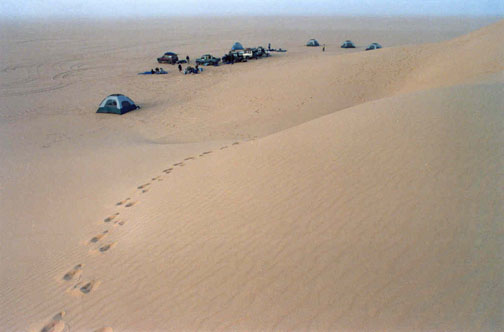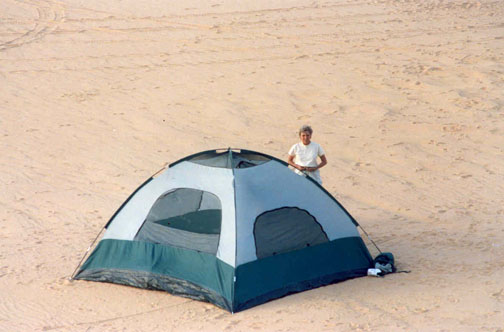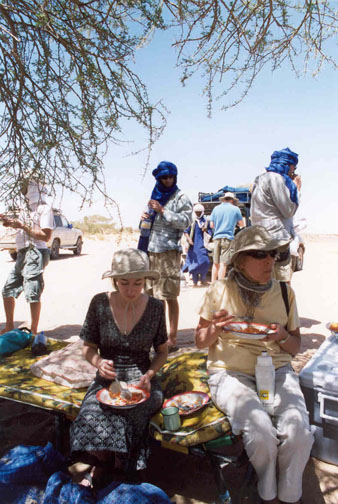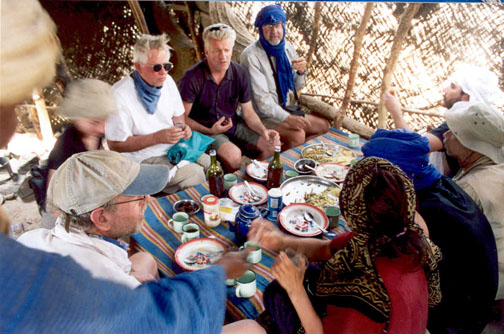
We set up camp near some dunes for our first night in the desert





blowing wind

Once we reached our campsite, often a half hour or an hour before the 6:30 sunset, the Tuaregs would immediately set up two campfires — for dinner, heating water for the high octane, very sweet Tuareg green tea, and eventually to burn the wastepaper. Meanwhile, tents were popped up pretty quickly after sites were picked out because it rapidly became dark.
Though the daytime temperatures were very hot, it felt much cooler in the shade (90s to 100s) because of the very low humidity. In the evening, the temperatures dropped into the quite comfortable seventies. At night, the temperatures would continue to drop to about 60°.
Sleeping in the desert was very pleasant — because of the moderate temperatures and the silence of the desert (no animal sounds, no rustling of leaves, not to mention garbage trucks or loud drunks passing by, really, no sounds at all) — except for the first couple of nights when tremendous gale-force winds made it sound as if our tents would be destroyed, tent flaps buffeting us (it became necessary to slink down into one's sleeping bag to avoid this), the corners of the tents (along with our legs) were frequently lifted up by the violent force of the winds. I didn't get much sleep those nights.
Because we had no toilets and running water, we got pretty dirty and needed to be careful about sanitation. In lieu of toilets, we would dig a little trench in the sand (when needed) with a foot, "conduct business," cover with sand, put the toilet paper in a small black plastic bag, wipe our hands in the sand, and rub a little liquid sanitizer into our hands. The toilet paper was usually burned once or twice a day in an extinguishing campfire, rather than leave it in the desert — a problem because the lack of humidity meant that even biodegradable items never decomposed.
Despite all warnings from guidebooks, on the road we drank mostly Agadez tap water (and sometimes desert well water?), which we were assured was safe and parasite-free. Whether or not this was true, we had no other options. We were in constant need of water and drank plenty.
Most of our meals were served on a couple of carpets surrounded by several six-foot long sleeping cushions on which we sat. Often dinners began with a serving or two of the Tuareg tea, water, and peanuts or green olives. Though dinners usually had a meat component (lamb, goat, tuna, beef), the vegetarians were generally not shorted (except for one dinner, which was just fresh open-oven-baked bread). Fresh carrots and tomatoes sometimes supplemented canned string beans, peas, carrots, and soup. Starches included couscous, rice, pasta, or potatoes. We often had a dessert, which could be pudding, applesauce, canned pineapple, peaches, or pears. For most the trip, we got ice water for dinner because of a large cooler of ice, which worked remarkably effectively.
Breakfast usually included Tuareg tea, French bread (which had lost all freshness a day or two into the desert), jam, honey, coffee, Lipton tea, a watery oatmeal (gruel?) that wasn't too bad.
Unlike dinner and breakfast, lunches were prepared mid-dash through the desert — in the heat of the day. Once or twice an acacia tree provided some shade, but mostly the cars would circle to create a modestly successful wind and sand break. We had to skip one lunch altogether because we were running late and were being subjected to terrific winds of dust and sand. Nevertheless, the cooking crew sometimes managed to prepare lunches with fresh tomatoes, carrots, onions, and beets, as well as canned veggies, the occasional orange, Tuareg tea, couscous, etc., and, of course, water.
Our final dinner in Niger was at Agadez's fanciest restaurant — an open air Italian restaurant in a picturesque two-story mud brick building. Ruth and I were a little concerned when a handwritten piece of paper, the menu, was circulated. It listed the main course as some veal dish. Fortunately, they announced there would be a vegetarian option, which turned out to be two kinds of homemade ravioli with parmesan cheese. A fabulous dish! That was accompanied by an excellent tomato-carrot-basil salad, bread, drinks, and gelato for dessert.